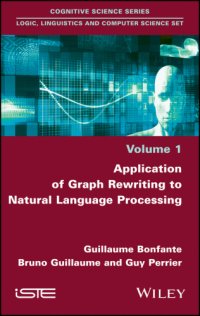
Ebook: Application of Graph Rewriting to Natural Language Processing
Author: Bonfante Guillaume, Guillaume Bruno, Perrier Guy
- Tags: Computational linguistics, Graph theory--Data processing, Language and logic, LANGUAGE ARTS & DISCIPLINES--Linguistics--Historical & Comparative, Rewriting systems (Computer science), Electronic books, Graph theory -- Data processing, LANGUAGE ARTS & DISCIPLINES -- Linguistics -- Historical & Comparative
- Series: Cognitive science and knowledge management series., Logic linguistics and computer science set 1
- Year: 2018
- Publisher: John Wiley & Sons Incorporated
- City: London
- Language: English
- epub
Cover; Half-Title Page; Title Page; Copyright Page; Contents; Introduction; 1. Programming with Graphs; 1.1. Creating a graph; 1.2. Feature structures; 1.3. Information searches; 1.3.1. Access to nodes; 1.3.2. Extracting edges; 1.4. Recreating an order; 1.5. Using patterns with the GREW library; 1.5.1. Pattern syntax; 1.5.2. Common pitfalls; 1.6. Graph rewriting; 1.6.1. Commands; 1.6.2. From rules to strategies; 1.6.3. Using lexicons; 1.6.4. Packages; 1.6.5. Common pitfalls; 2. Dependency Syntax: Surface Structure and Deep Structure; 2.1. Dependencies versus constituents.;The paradigm of Graph Rewriting is used very little in the field of Natural Language Processing. But graphs are a natural way of representing the deep syntax and the semantics of natural languages. Deep syntax is an abstraction of syntactic dependencies towards semantics in the form of graphs and there is a compact way of representing the semantics in an underspecified logical framework also with graphs. Then, Graph Rewriting reconciles efficiency with linguistic readability for producing representations at some linguistic level by transformation of a neighbor level: from raw text to surface syntax, from surface syntax to deep syntax, from deep syntax to underspecified logical semantics and conversely.
Download the book Application of Graph Rewriting to Natural Language Processing for free or read online
Continue reading on any device:

Last viewed books
Related books
{related-news}
Comments (0)